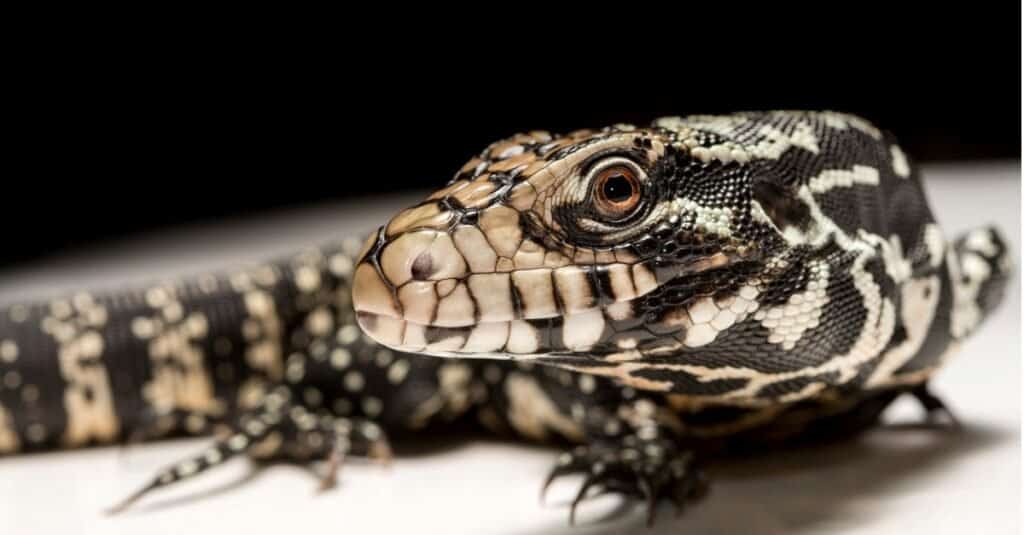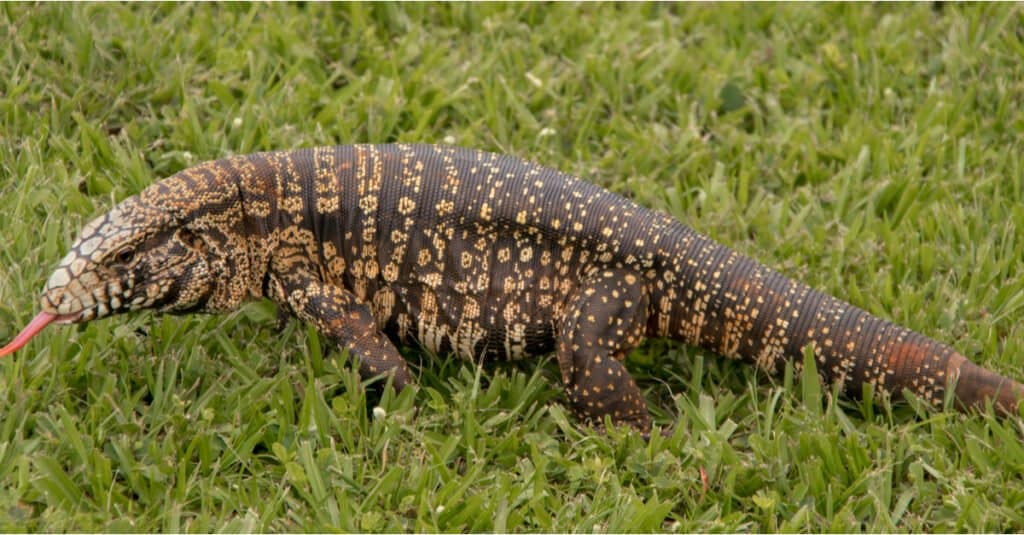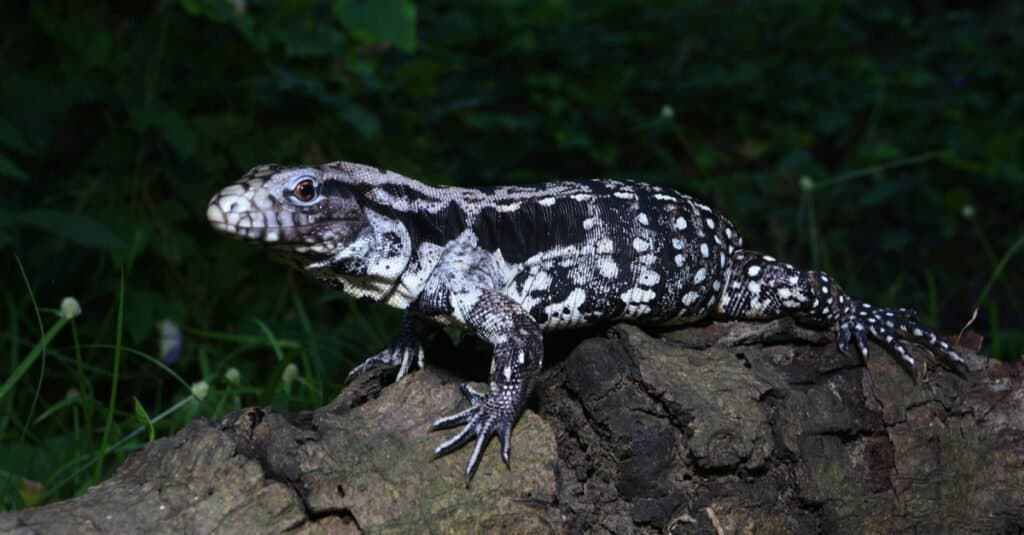Do you want to learn all about one of the world’s coolest and largest types of lizards? Tegus are large lizards native to Central and South America. This large lizard can be found in the wild as well as kept as a pet. As pets, they have become popular in Florida, despite their South American origin. This exotic reptile is actually quite a popular pet choice among reptile enthusiasts. They tend to be highly sought after in particular because of the striking black and white dotted pattern on their backs. However, not only are they impressive in their appearance, but they are also incredibly intelligent.
Are you curious to learn more about these tegus? If you’re considering keeping one as a pet, would you like to know more about it and how to feed it? Find out all about what tegus eat and more!
Quick Breakdown on Tegus

Tegus are known for their black and white spotted backs.
©iStock.com/Rafael Cutó
A tegu is a lizard that belongs to the families Teiidae and Gymnophthalmidae. They can be found in South America and southern parts of North America. However, they are only native to Central and South America. They live in a wide range of habitats, including savannas, rainforests, meadows, and tree-covered dry forests. Normally, tegus live on land, but young ones spend more time in trees because they need to protect themselves from predators. To regulate their body temperature in order to forage, tegus spend a lot of time in the sun.
It must also be noted that these reptiles are also quite large. The weight of these reptiles can range from 5 ½ pounds to almost 16 pounds. They can even grow to be about 4 to 4.5 feet long. In fact, it is not uncommon for an adult female to be about three feet long. As well as being large, tegus also possess powerful legs and long tails. Overall, these lizards are incredibly fascinating and quite big and powerful.
Additionally, they make excellent pets since they have a very chill nature. In fact, they are capable of getting used to their owners and even becoming house-trained over time. The only thing to keep in mind is that they can be aggressive if they’re not handled properly. Overall, the tegu is a pretty cool lizard that many love to house as a pet! Now let’s take a look at what tegus eat!
What Do Tegus Eat?

A tegu is classified as an omnivorous scavenger, meaning it can eat most things that it finds.
©Arne Beruldsen/Shutterstock.com
Tegus eat a diet that consists of insects, eggs, fruits, and small animals such as rodents and other lizards. Since they have such a varied diet, they are considered omnivores. However, their main diet consists mostly of fruits and leaves. Still, they will also feed opportunistically on invertebrates, carcasses, and animal tissues, including those of other lizards and birds.
There are also at least 3 established populations of this invasive species in Florida, where it was introduced via the pet trade. A study published in 2021, looking into the diet of invasive tegu lizards, found that despite not living in their natural environment, Argentine Black and White Tegus in central Florida are generalist omnivores and consume a wide range of species across the food chain, including threatened species. It’s also known that Tegus eat eggs, and in Florida, they’ve been known to eat eggs from American alligators. Tegus in Florida have also eaten gopher and tortoise hatchlings.
After learning more about the diet of a tegu, let’s look at a complete list of what tegus eat.
Complete List of What Tegus Eat
As we mentioned, tegus are primarily omnivores. This means that they have an incredibly varied diet. However, in the early stages of their lives, they need a lot of protein to help fuel them in order for them to grow. However, once they reach adulthood, much of their diet begins to consist of fruits and leaves.
The complete diet of a tegu consists of the following:
- Insects such as cave roaches, mealworms, silkworms, black soldier fly larvae, locusts, dubia roaches, earthworms, hissing roaches, snails, grasshoppers, crickets, death’s head roaches, and discoid roaches.
- Meat sources such as gerbils, hamsters, rats, frogs, mice, nonvenomous snakes, quail hatchlings, fish, crayfish, eggs, ground chicken, and beef heart.
- Vegetables such as cactus pads, dandelion, hibiscus flowers, alfalfa, squash, yam, rose flowers, carrots, cilantro, kale, turnips, collard greens, carnation flowers, and parsnip.
- Fruits such as cactus fruit, papaya, figs, melon, mango, strawberries, apples, blueberries, blackberries, dates, grapes, and cherries.
Tegus have an extremely varied diet, as you can see. For them to grow and function properly, they need a very balanced diet.
How Do Tegus Hunt & Forage For Food?
Having learned what tegus eat, let’s explore how they forage. It is imperative that tegus warm up their body temperature before searching for food since they are lizards. Their digestive system will not function properly without a proper internal body temperature. As far as food goes, tegu lizards feed on anything they can catch or find in the wild. It is important to know that they are scavengers and are not particularly picky about the type of food they consume.
Tegus use their tongues to detect prey, the same way snakes do. They have forked tongues in order to make it easier for them to determine which direction to go when they are looking for food. A small organ that is located on the roof of the mouth called Jacobson’s organ is responsible for processing scent particles on the tongue. Additionally, this allows one to determine the side of the tongue that the scent is coming from. In the event that their tongue picks up a scent on the right, the tegu proceeds to the right. A scent picked up on both forks means that the scent is coming from straight ahead.
What Does A Pet Tegu Eat?

A tegu makes for a pretty great pet as it is quite docile and can become adapted to its environment.
©dwi putra stock/Shutterstock.com
Whether you’re thinking about getting one or already have one, you may wonder, “What can I feed my tegu?” As we’ve discussed, tegus, in the wild, depend on seasonal and regional food availability for their diet. You will need to provide your pet tegu with a healthy diet that includes a variety of prey, fruit, and vegetables, in addition to supplemented food.
In the wild, hatchlings and juveniles are primarily insectivores, but they can learn to eat other foods in captivity. It is important to place a strong emphasis on feeding insects to hatchlings on a daily basis. The majority of the diet should consist of crickets, dubia roaches, mealworms, and earthworms. Tegus under the age of three should still be fed every other day until they’re sexually mature and about the size of an adult. For smaller tegus, whole prey like smaller mice makes for a perfect meal. Meanwhile, the bigger tegus can eat adult mice of different sizes.
An adult pet tegu’s main food should be rodents, small rats, and the occasional baby chick. Aside from insects and eggs, fish should also be offered as a source of food. Every once to twice a week, tegus should be given calcium and multivitamin supplements with their meals. By doing so, they will ensure that they are getting everything they need from their diet. If you want to keep your pet tegu from gaining too much weight, keep fruit in moderation in their diet.
What Feeds On Tegu In The Wild?
What hunts on tegus in the wild? We’ve covered everything tegus eat, but what hunts on them in the wild? Are there any natural predators that prey on them? Since tegus are pretty large lizards, they don’t have a lot of natural predators. Luckily, although they spend a lot of on the ground since they are terrestrial creatures, they are also excellent swimmers. This helps to avoid trouble when necessary. Moreover, tegus are fast runners, so catching one is nearly impossible. However, there are still some animals that will hunt on tegus. The main predators of tegus are pumas, birds of prey, and snakes.
The photo featured at the top of this post is © dwi putra stock/Shutterstock.com
Thank you for reading! Have some feedback for us? Contact the AZ Animals editorial team.







